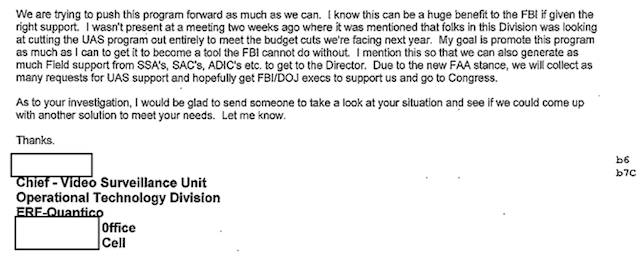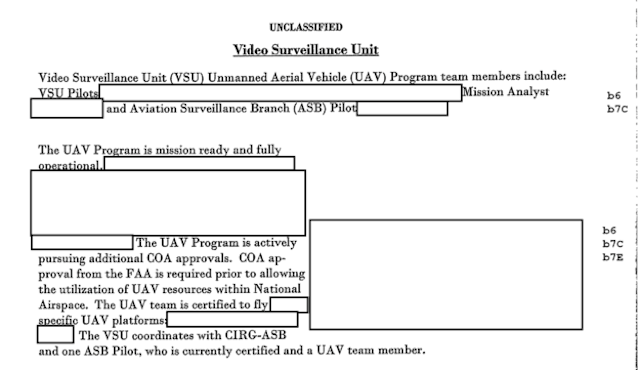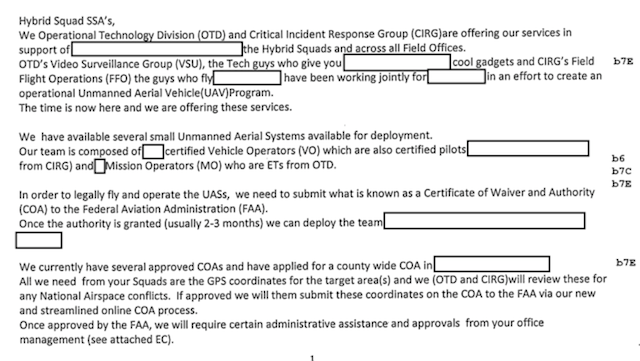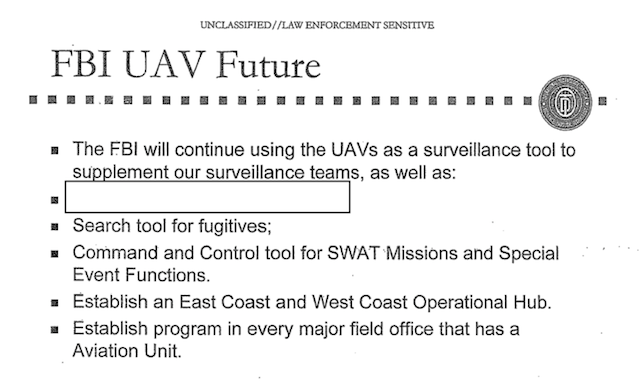A version of this story originally appeared on Motherboard – Vice and MuckRock
By Shawn Musgrave
The Federal Bureau of Investigation has had an eager eye on surveillance drones since first experimenting with remote control airplanes in 1995. But budget cuts nearly ended the Bureau’s unmanned plans in 2010, and it took a dedicated push aimed at making drones “a tool the FBI cannot do without” to cement their place in the FBI’s surveillance toolkit.
The near termination—and subsequent expansion—of the FBI’s drone program over the past four years is chronicled in hundreds of (heavily-redacted) pages released following a lawsuit filed by Citizens for Responsibility and Ethics in Washington.
The FBI’s Video Surveillance Unit took over the agency’s drone program in summer 2010. The Technical Response Unit, another component within the Operational Technology Division, had been overseeing the program since 2003. The FBI flew its first operational drone mission in October 2006, but documents suggest no operational deployments were flown in the four years between then and when VSU took over the program.
Two months after the handoff, the VSU Chief described the program’s near-termination and the unit’s ambitions for unmanned vehicles.
“I know [this program] can be a huge benefit to the FBI if given the right support,” wrote the VSU Chief. “I wasn’t present at a meeting two weeks ago where it was mentioned that folks in this Division was [sic] looking at cutting the UAS program out entirely to meet the budget cuts we’re facing next year.”
The released FBI documents do not indicate what saved the agency’s drones from the budget hangman. But the VSU Chief’s vision upon taking up the program was to make it “a tool the FBI cannot do without.” This would require building demand for drone backup from field agents, as well as drumming up support among senior FBI and Justice Department officials.
As it entered a new fiscal year, the FBI drone team set a number of goals to advance the program, which included codifying a process for field offices to request unmanned technical assistance. The Quantico-based team spread word of their wares, and described the protocol to request them through a variety of channels. In a May 2011 newsletter, the VSU announced to agents from coast to coast, “The UAV Program is mission ready and fully operational” and is “actively pursuing additional [Federal Aviation Administration] approvals.”
The program manager also sent an email in July 2011 to top-ranking agents in “hybrid squads” along the southwest border and in California, including in Albuquerque, El Paso, Phoenix, San Antonio, San Diego, and San Jose.
“The time is now here and we are offering these services,” the email read, imploring field agents to request unmanned aerial assistance. “We have available several small Unmanned Aerial Systems available for deployment.”
These promotion efforts apparently paid off. The FBI flew at least two drone missions in 2011, and agency documents indicate that at least six unmanned surveillance operations were approved the same year. One April 2011 mission proposal was rejected because of concerns for the “safety of nonparticipating aircraft.” The final memo noted that the rejected request was “well written,” even if it could not be authorized.
Whereas fiscal year 2011 nearly saw the end to FBI drone use, 2012 saw a considerable upswing in budgeted UAV expenditures.The exact figures are redacted, but a March 2013 email from the Operational Technology Division Chief conveys how much more money the program spent in 2012 over the previous year.
From the FBI’s sole redaction slip-up, we know that the agency had three small drones as of December 2010, and the drone team filled out its inventory significantly in 2012. The department also made plans to continue to expand.
A July 2012 slideshow looked forward to a not-too-distant “FBI UAV Future,” when the Bureau would establish “an East Coast and West Coast Operational Hub” to coordinate drone missions as well as maintain standalone drone programs in all major field offices with aviation units.
A recruitment email from fall 2012 predicted, “Within the next two years the UAV program will double in size and hopefully triple in the amount of requests for UAV deployments.” Another projection from September 2012 foresaw back-to-back doublings of the FBI drone inventory in fiscal years 2013 and 2014, and “utilization to increase exponentially” along with expanded visibility.
Two years later, these drone-in-every-pot dreams are hardly reality, and the VSU’s enthusiasm has been reined in. In September 2012, for example, an FBI Contracts Officer refused to allow the drone program manager to play loose with purchase orders after a manufacturer dropped prices.
“It’s hard to see the money let go, I know,” read the contract officer’s response to the UAV manager, “but I cannot violate Federal Appropriations Law.”
The UAV budget was also cut in fiscal year 2013, presumably derailing the visions of expansion ushered in by the program’s hand-off to the Video Surveillance Unit in 2010.
Even with the brakes pumped, though, the FBI managed to spend $3 million on drones from 2004 through May 2013, according to figures released by the Justice Department Inspector General last fall. This may seem paltry next to the FBI’s $8.3 billion annual budget, but this figure is significant given that the Bureau flew only ten drone missions in that period, for a rough cost of $300,000 per operational deployment.
“It’s hard to see the money let go, I know, but I cannot violate Federal Appropriations Law.”
Even more significant than securing current funding, the FBI drone team’s efforts secured buy-in from field agents and headquarters officials alike, all the way up to the Director’s office. In February 2013, FBI Director Robert Mueller, III, requested a personal UAV demonstration. Four months later, Mueller confirmed before the Senate Judiciary Committee that the FBI had a small inventory of drones, but emphasized that “our footprint is very small, we have very few and of limited use.”
In December 2013, FBI senior leadership were treated to another “capability demonstration/briefing” which offered attendees “the chance to operate a system if they are interested in doing so.”
In the span of three years, the FBI’s drone program went from budgetary gristle to a matter for the Director’s attention. Drones may not yet be indispensable to the Bureau, but they have generated considerable momentum as a low-cost, low-profile surveillance tool. We have few details about how many units the Bureau has, where they’ve been deployed and what privacy protections are in place, but it seems that FBI drones are here to stay.
[includeme file=”tools/sympa/drones_sub.php”]





